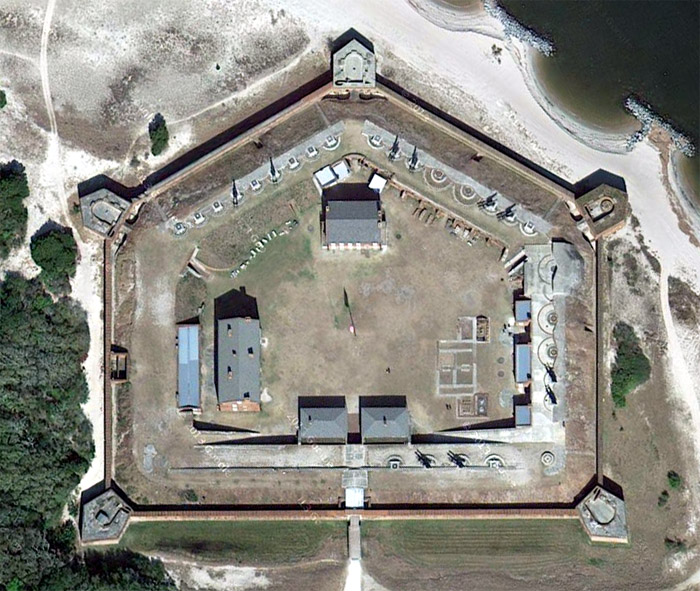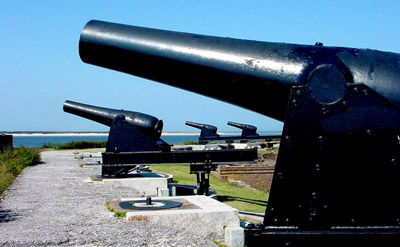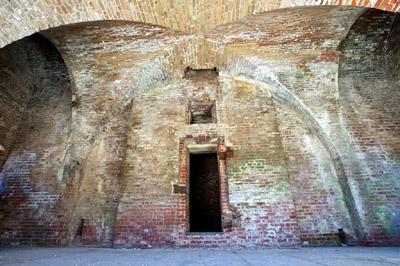 |
Fort Clinch
Amelia Island, Florida, USA
|
 I visited Fort Clinch in April of 2014! Click here to read of my exploits! |
 |
Constructed: 1847 - 1867
Used by: CSA, USA
Conflicts in which it participated:
US Civil War
|
French Huguenot explorer Jean Ribault (1520-1565) was the first European to visit the island the native Timucua Indians called Napoyca, in 1562. Being unable to pronounce Napoyca, Ribault renamed the island Île de Mai, then hastened inland to build Fort Caroline so that he could more effectively outrage the Spanish, who considered Florida to be their personal property. Ribault and many of his followers would be slaughtered by the Spanish in 1565.
|
 |
|
|
The Spanish soon renamed the island in quesion Isla de Santa María, as Franciscan monks had arrived in 1573 and established the Santa María de Sena mission there.
The glorious British Empire began doing its distinctively aggressive colonial thing in the region by the mid-17th century (as opposed to France's, Portugal's, Spain's, and/or Holland's aggressive colonial thing: In the long run, though, the British did it arguably better than anyone else). Although still possessed by Spain, Georgia's founder and colonial governor James Oglethorpe (1696-1785) renamed the island yet again, after Princess Amelia (1711-1786), daughter of Britain's King George II (1683-1760).
|
 Black is beautiful: The lovely Rodman Guns of Fort Clinch Black is beautiful: The lovely Rodman Guns of Fort Clinch |
 |
Amelia Island, along with much of the border betwixt Georgia and Florida, served as a buffer zone between Spanish and British colonial holdings until the end of the Seven Years' War (1754-1763). The Treaty of Paris (1763) gave Florida to Great Britain, for which Britain returned Havana to the Spanish.
And then of course there was the US Revolutionary War (1775-1783), the conclusion of which returned most of Florida to Spain! Poor, confused Florida. |
|
The site at which Fort Clinch now menacingly squats had been occupied on and off by troops since 1736, because of the St. Marys River. This river starts at the Okefenokee Swamp and winds in a bewilderingly twisty fashion for 126 miles and enters the Atlantic Ocean right at the northern tip of Amelia Island: It marks the border between eastern Georgia and Florida. Though the St. Marys River doesn't swing through any major population centers, it did represent a tempting route inland for crafty seaborne invaders, plus the deepwater port at Fernandia was the eastern link to Florida's only cross-state railroad.
Spain was back in charge on Amelia Island, but their new American neighbors were a frisky lot indeed. In June of 1795 a group of American "rebel marauders" attacked and dispersed the Spanish garrison in the colonial town of Fernandina (on the northern side of the island), then built a battery and bravely raised...the French flag (?!). Unamused, the Spanish returned with a larger force on August 2 and sent the rascally marauders, cackling maniacally, back over the St. Marys River into Georgia.
US President James Madison (1751-1836) became convinced that all of Florida could be annexed to the United States in 1810: This despite the Spanish colonial governor's stated intention to cede only the western portion of Florida to the US. Madison sent American Revolutionary hero, Congressman, Governor of Georgia and general troublemaker George Mathews (1739-1812) into Eastern Florida, in a deniable fashion, in 1812. Mathews mustered a group of Georgians who, calling themselves the Patriots of Amelia Island (and aided by a number of US Navy gunboats), launched Madison's secret revolution by capturing Fernandina on March 13, 1812.
The next day, the Patriots "surrendered" Fernandina to a contingent of 250 US troops that just happened to be hanging around nearby, and the stars 'n' stripes were raised o'er Amelia Island. U!S!A!
|
The locals were incited to throw off the shackles of wicked Spanish oppression, but as events wore on, the US congress got its collective knickers in a twist about the mounting possibility of causing a war with Spain over this eastern Florida nonsense. Particularly as the declaration of war against another great European power, Great Britain, was being prepared (the War of 1812 (1812-1814) officially began on June 18, 1812), the decision was made to leave Fernandina to the Spanish...for now. Once back on Amelia Island, the Spanish built a vaguely starrish fortification, Fort San Carlos, in 1816 to defend Fernandina from future American foolishness, and to protect the strategically important Amelia River. |
 |
The adorable Fort San Carlos, which did not survive the 19th century. Click the image for a plan for Fernandina in 1811. |
|
In 1819 Spain and the United States signed the Adams-Onís Treaty, ceding all of Florida to the US, which took possession in 1821. Settlers moved in at a steady clip, which inevitably led to clashes with Seminole Indians, who had not been consulted about these changes, other than being informed that they would now live on a reservation in the center of Florida. Three Seminole Wars were fought between 1816 and 1858. A prominent figure in these was War of 1812 veteran Duncan Lamont Clinch (1787-1849), whose somewhat inadvertant slaughter of hundreds of Seminoles and escaped black slaves at a place called Negro Fort (later to be the location of Fort Gadsden) in southern Georgia in 1816 (a shell fired from a gunboat under Clinch's command struck the fort's powder magazine, killing everyone inside, which may or may not have been Clinch's intention) contributed the start of the First Seminole War. Those who are still paying attention at this point will have realized that it was after ole Duncan Lamont that Fort Clinch would be named.
|
|
 |
Construction of the fort of our current interest began in 1847, after the end of the Second Seminole War. With an eye towards keeping that eye on the nearby Seminoles and protecting the Cumberland Sound and entrances to the St. Johns and Amelia Rivers from whatever French, Spanish, British or whomeverish navies might come calling, the fort remained nameless until the convenient demise of Duncan Lamont Clinch in 1849. |
|
Fort Clinch is pentagonal in shape, with bastions at each corner. This shape, less starrish than one's heart might desire, was common for forts of the Third System of US seacoast fortification (witness Forts Jefferson, Delaware and Zachary Taylor for more examples of this phenomenon). Fort Clinch was designed to mount 70 heavy guns, but was never fully armed. Nor was it ever even completely finished! Obviously not high on anyone's list of priorities, construction lingered on for several years, and by the time Florida seceded from the Union on January 10, 1861 (Northern newspapers referred to Florida as "the smallest tadpole in the dirty pool of secession"), the Federal government had left only a single caretaker sergeant at Fort Clinch. Florida Militia arrived on the scene as soon as they could and relieved the sergeant of his burden, occupying Fort Clinch, which served as a haven for Confederate blockade runners during the first year of the US Civil War (1861-1865). |
When Federal troops were advancing into the area in early 1862, however, Fort Clinch was ordered abandoned by Robert E. Lee (1807-1870). Lee felt that masonry forts were obsolete when faced with rifled cannon, such as those employed by the boys in blue, who happily reoccupied Fort Clinch. The decision to give up the fort without a fight was ridiculed by some in the south, but the following month Lee's concerns proved prophetic when Fort Pulaski, in Savannah, Georgia, was pounded into surrender by the James Rifled Cannon and Parrot Guns of the Union. |
 |
 Just a few of Fort Clinch's 5,000,000+ bricks! Just a few of Fort Clinch's 5,000,000+ bricks! |
|
A little more work was done on Fort Clinch after the war, but by 1869 it had been placed back into caretaker status. Units of the 6th US Artillery regarrisoned the fort in early 1898, thanks to the Spanish-American War (1898). Fort Clinch escaped the concrete-disfigurement fate of many US coastal forts during the Endicott Period for much the same reason that it was never entirely completed or armed: It just wasn't strategically cool enough!
One Rodman Gun's carriage was reconditioned to accept an M1888, an 8" rifled gun, but that wasn't enough to retain the interest of the artillery troops, who left in September of 1898, their dreams of violently preventing Spain from reclaiming Amelia Island unfulfilled.
The state of Florida bought the abandoned fort and its environs in 1935. The Civilian Conservation Corps did its conservation thing, and Fort Clinch State Park, one of Florida's first state parks, opened to the public in 1938...a public which was then chased away during the Second World War (1939-1945), when the fort was reoccupied by the US military. Fort Clinch spent that war as a "communications and security facility."
Today, communicative and secure, Fort Clinch beckons enticingly to anyone who might travel in its general direction. Several of the fort's interior buildings have been reconstructed, and the finest concept of modern life is also represented: The gift shop. Fort Clinch is open from 8am 'til sundown year 'round.
|
|
|
|
|
|
 |




